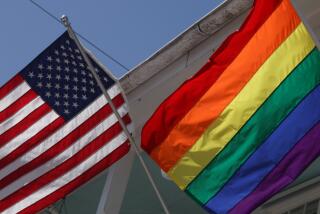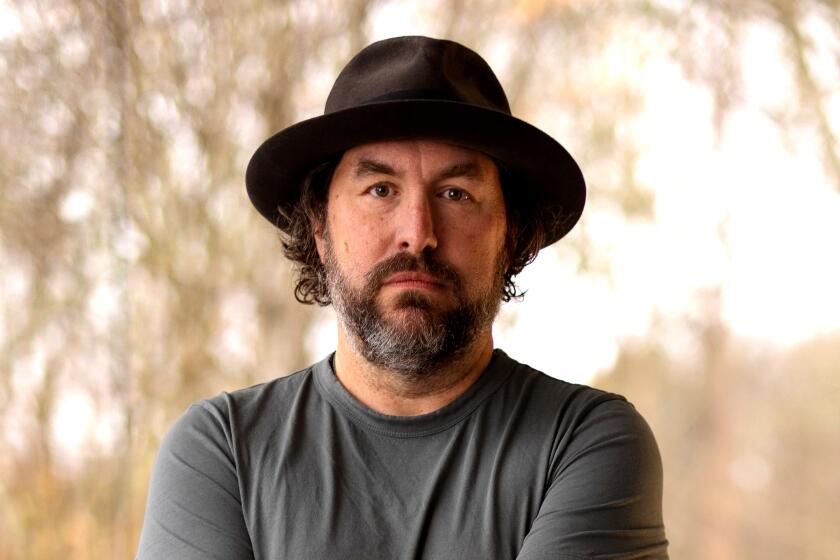Out of Hollywood’s Closet
“The time has come when we can seriously and without sensationalism assess the gay and lesbian experience of studio-era Hollywood,” wrote William J. Mann in “Wisecracker,” a biography that explored the very public “private life” of gay silent-era-leading-man-turned-interior-decorator-to the-ruling-class, William Haines. Taking his cue from Neal Gabler’s “An Empire of Their Own: How the Jews Invented Hollywood,” Mann’s new book about gay Hollywood, “Behind the Screen,” endeavors to explain how gays and lesbians shaped the industry.
Even those readers less than familiar with the studio era’s rise and fall--or gay politics and social history, for that matter--are relatively well aware of the fact that the same-sex-oriented played a major role in it. The sticking point is precisely how that role was played, given the paradox of the culture’s stated disapproval of gays and lesbians, and the haven that places like Hollywood provided for sexual nonconformists.
Although the film industry’s gays and lesbians had freedom, they did not--until the 1990s--have any real degree of make or break power. Moreover there’s a decided difference in tone between a minority that formally stated its desire to enter the American mainstream, as exemplified by Louis B. Mayer’s mom-and-apple-pie paeans to the fictional ultra-WASP Hardy family, and that “minority within-and-without” of gays who, while never deigning to raise their voices, slipped one past the goalie, as the saying goes, from time to time--as, for example, in Jack Cole’s eye-poppingly homoerotic “Is There Anyone Here for Love?” musical number in “Gentlemen Prefer Blondes.”
“If you gave them the right image, they didn’t care what you did when you left the studio,” screenwriter Robert Shaw tells Mann. “But on the other hand,” costume designer Miles White demurs, “of course they did, and you weren’t free at all.” So which is it? As usual in a culture fueled by cognitive dissonance, both. For the Shaw and White statements echo that ceaselessly intoned status quo mantra, “I really don’t care what you do in bed--but do you have to talk about it?”
Well, as a matter of fact, yes. For, as history has proved time and time again, if “it” isn’t talked about, then “it” gets socially and (even more important) psychically cordoned off as “the forbidden” and, consequently, “the unspeakable.” Ever since homosexuality was invented as a behavioral category by Karoly Maria Benkert, a Hungarian physician, in 1869 and adopted by the medical profession as a quasi-disease (mental illness or “genetic defect,” take your pick) in the 20th, a prolonged struggle ensued to get this “elephant in the bedroom” (and everywhere else in the “house” for that matter) recognized as a simple fact of life.
Though this struggle has by no means ended, the last four decades have seen the “unspeakable” spoken with increasing regularity, if not honesty, in autobiographies such as Arthur Laurents’ “Original Story By” and David Graham’s “Casting About.” And just last year, same-sexuality figured in major news stories about everything from hate crime laws to gay marriage debates to the Boy Scouts controversy, the Salvation Army scandal and the online sexual peccadilloes of HIV-positive reactionary uber-pundit Andrew Sullivan. But no matter what the setting or particulars may be, when same-sexuality is at issue, all roads lead to Hollywood. The movies are where one finds people on display in their most idealized form. Or--to put the entire subject on a more vulgar National Enquirer level--the movies are the most acceptable route to divining who’s gay and who isn’t.
Mann doesn’t play that game. To begin with, while the usual stars make their expected appearances (Rock Hudson, Montgomery Clift, Marlene Dietrich, for instance), and as he’s dealing with the Hollywood of yore, Mann doesn’t risk raising the ire of today’s ultra-litigious stars. Still, he’s overall far more interested in the people behind the camera than those in front of it. More important, he’s well aware that “the closet is not an appropriate construct” for describing gay and lesbian life at any level in the studio era; Mann prefers the far more helpful terms “overt” and “circumspect” to describe people and contexts.
Although by today’s standards director George Cukor would be considered closeted, in the Hollywood of his 1930s to 1950s heyday he was quite overt. The integrated lives of today’s gay celebrities weren’t possible back then. But, being successful, respected and well-liked among his peers, Cukor was able to navigate a “private life” the average gay or lesbian of that era would deem unparalleled in its freedom. He stands in marked contrast to Charles Brackett, the screenwriter, producer and writing partner with Billy Wilder of such classics as “The Lost Weekend” and “Sunset Boulevard.” Wilder described him as “a right-wing Republican conservative, a formal man, always impeccably dressed, who made entries in his diary every evening.” There probably weren’t any diary entries about Brackett’s lover, a young assistant named James Larmore, whom the older married man arranged to have his daughter Alexandra marry.
If “Behind the Screen” has a bombshell, this May-December alliance--which, in the words of portraitist Don Bachardy, “one just knew”--is it. But Mann, despite a sometimes annoying habit of grandly announcing that information he’s about to supply is being offered “for the first time,” doesn’t overplay his hand when it comes to “outing” the past. We learn of both obscure silent cowboy star J. Warren Kerrigan (who would have been more at home in the Astor bar than on the lone “prairee”), and that world-famous unsolved Hollywood murder victim William Desmond Taylor. But he also tells us about George James Hopkins, the stylist who engineered the transformation of Theodosia Goodman into “vamp” supreme Theda Bara. And then there’s “I Remember Mama,” George Stevens’ incredibly moving tribute to “family values” produced by Louella Parsons’ lesbian daughter, Harriet, and written by DeWitt Bodeen--a brilliant gay screenwriter whose credits include “Cat People.”
Clearly there were professions within the industry that were more “gay friendly” than others. Mann tells much about the careers of set decorators Henry Grace, Hopkins (whose credits include “A Streetcar Named Desire”) and Howard Bristol (“Rope”) taking into account a gay-bashing incident the latter suffered. But the most generous portion of the book covers Hollywood’s top gay costume designers: Adrian, Travis Banton, Walter Plunkett and Orry-Kelly. The first two, though wildly flamboyant and “obviously” gay, went so far as to marry. Mann notes that the decidedly macho Kelly, who once kept company with the young (pre-Randolph Scott) Cary Grant, never married.
This of course connects to the perennial problem presented by gay “visibility.” The “obvious” gayness of Edward Everett Horton, Franklin Pangborn is one thing. The turban-and-make-up-besotted Vincente Minnelli--who had alliances with women other than Judy Garland--is quite another. Mann is most amusing in noting the “gay markers” of Clifton Webb, yet he’s as at a loss for words in explaining how and why he became--at a very advanced age--a major “mainstream” movie star. (Who can forget Dolores Gray in “It’s Always Fair Weather” singing the lyric “But I’ve got a guy who’s Clifton Webb and Marlon Brando combined”?) Clearly the same sort of willful mass audience blindness that placed Liberace on this “family entertainer” pedestal is the key. But a better answer would require a study of the mass psychology of “denial” that so far no one has attempted.
Mann shows surprising tact in all of this. He confesses to finding nothing “queer” to report about the lives of Judith Anderson, Agnes Moorehead and Barbara Stanwyck. But, the lesser-known (though in many ways just as fascinating) Ona Munson, Margaret Lindsay and Lilyan Tashman are accounted for. Mann is also excellent on the deeply “circumspect” Claudette Colbert--who the irrepressibly cheeky Bachardy refers to as “Uncle Claude.” Colbert, Mann tells us, “may have never actually used the term ‘lesbian.’” And as every gay and lesbian individual knows, that’s all the difference in the world--both personally and publicly. Dietrich and Garbo, whose sapphic dealings are far better-known, didn’t use it either. Ultra-butch director Dorothy Arzner (who, Mann tells us, once had a fling with Billie Burke) took grave exception to it. And when he was living with character actor Anderson Lawler, Gary Cooper would doubtless have been shocked to have been referred to as “bi.”
Shock, needless to say, persists in the public mind as central to gay Hollywood. Are careers truly “at risk” if “the truth were to come out” about actor’s off-screen lives? That’s the $64,000 question. The answer will doubtless be argued until that happy day (which may be arriving sooner than many imagine) when interest in things gay won’t be considered scandalous at all.
*
David Ehrenstein is the author of “Open Secret: Gay Hollywood 1928-2000.”
More to Read
Sign up for our Book Club newsletter
Get the latest news, events and more from the Los Angeles Times Book Club, and help us get L.A. reading and talking.
You may occasionally receive promotional content from the Los Angeles Times.









